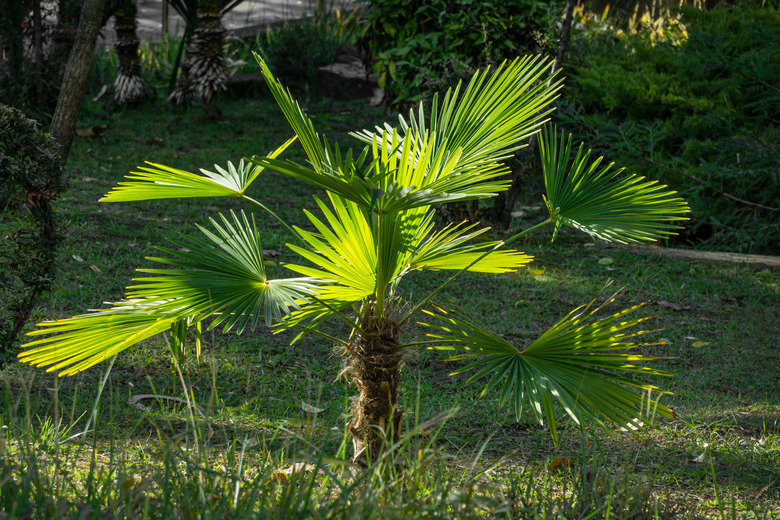How To Make A Windmill Palm Grow Fast
We may receive a commission on purchases made from links.
The compact size of windmill palms (Trachycarpus fortunei, U.S. Department of Agriculture plant hardiness zones 7 through 11) makes them perfect additions to smaller landscapes seeking a tropical feel. Native to central and eastern China, this palm is considered hardy, although its growing conditions and care affect its health, which then affects its growth rate. Windmill palms grown in preferred conditions naturally produce new growth at a moderate rate of speed.
Windmill Palm Noteworthy Characteristics
Windmill Palm Noteworthy Characteristics
Windmill palms have an evergreen habit and grow anywhere from 20 to 40 feet tall with a canopy spread of around 12 feet. However, those grown in its coolest zone grow only around 10 feet tall. The single trunk covered in hairy fibers looks like it's wrapped in burlap sheets. In fact, mats, brooms and ropes are made from the fibers.
Large, fan-shaped leaves fill the canopy, with thorn-lined stems. Each frond averages around 3 feet wide and contains anywhere from 15 to 19 sections. In late spring and summer, 2-foot-long drooping panicles form that fill with showy yellow flowers. The spent flowers give way to small bluish drupes that contain the palm's seeds.
Many who live in climates typically too cold for the majority of palm species can successfully grow windmill palms. One of the most cold-hardy palm trees, they can usually survive winter temperatures dipping to 10 degrees Fahrenheit. However, those living in zone 7 should plant in a protected site sheltered from cold winter winds and add a thick layer of mulch to protect the root system.
Preferred Growing Conditions
Preferred Growing Conditions
Windmill palms grown in their preferred conditions can expect to put on anywhere from 2 to 3 feet of new growth yearly. Although you can't do anything to speed up the palm's natural growth rate, growing it in its preferred conditions produces the best growth. Any type of plant grown in conditions it doesn't prefer will show a slower rate of growth and be unhealthy.
Grow windmill palms on a site that receives full sun to partial shade, keeping in mind that partial shade produces the best growth. The palm thrives on well-draining soils that are organically rich. Don't plant windmill palms on soggy sites having a tendency to retain water because they promote disease problems like root rot which can kill the palm. Poorly-draining, full-shade sites negatively affect the palm's rate of growth.
Due to the windmill palm's compact size, they grow well planted in large containers. Just make sure the container has bottom drain holes and use a fertile, well-draining potting mix. Many potting mixes contain slow-release fertilizers, which cuts down on the palm's fertilizer requirements. Check the label to see how long the slow-release fertilizer lasts, because you'll need to begin applying fertilizer after the potting mix nutrients are spent.
Continued Care and Uses
Continued Care and Uses
Windmill palms have a moderate tolerance to drought, and weekly water applications during the growing season are sufficient. You can cut back to every couple of weeks or so during winter while active growth slows. Only prune fronds that are completely brown, as those containing some color are still providing nutrients to the palm. In spring, fertilize the windmill palm with a palm tree fertilizer, spreading it under the canopy and watering into the soil.
Their smaller size makes these palms great additions that lend a tropical feel to porches, patios and larger balconies, and they're well-used when framing an entryway. They also make eyecatching accent plants and specimens. Windmill palms add constant color to winter gardens and work as pool plants. Even those in colder locations can dress up outdoor spaces with the potted palm, then take it indoors to a bright location during winter. The palm makes an attractive addition wherever used.
